
Posts Tagged: kuroshio
What's Happening With Shot Hole Borer?
This is the most recent activity summary of a group of organizations working on the Invasive Shot Hole Borers and their associated fungal symbionts. This pest/disease complex affects avocado along with a large number of native and landscape plants in California, as well as in other parts of the world (http://ucanr.edu/sites/pshb/; http://ucanr.edu/sites/pshb/files/238251.pdf):
Invasive Shot Hole Borers
Quarterly Situation Report
January through March 2018
Executive Summary
Overview
Education, outreach, and monitoring activities were robust during the cool damp winter months of 2018. Infestations continued to dominate Orange, San Diego, and Los Angeles counties, with lesser activity in Ventura and Santa Barbara counties. The need for funding of research, education, outreach, and waste management associated with ISHB was brought to the attention of state governance. Preventative efforts to increase awareness of ISHB in unaffected counties continued. Collaborative efforts of numerous agencies, educational institutions, and non-profit groups resulted in the successful efforts listed below.
Statewide
The two-day Invasive Species Summit was held in the State Capitol for legislators and their staff to learn about environmental pressures and costs created by these species statewide. Three pieces of proposed legislation were written either specific to or with components addressing ISHB. They are: AB 2054 (Gonzlez Fletcher), AB 2166 – California Farm Bill, AB 2470 (Grayson) – Invasive Species Council.
The Statewide SHB Network convened telephonically to discuss ISHB, spread, threat, and help educate those in unaffected counties. An ISHB presentation was given at a statewide horticultural convention in northern California.
The triennial California Native Plant Society Conservation Conference was held near Los Angeles International Airport. ISHB was addressed at a pre-conference invasive species workshop, throughout the conference by tabling and poster session, and during the Invasive Species Session.
Regional
UCCE San Diego helmed a two-part GSOB/ISHB-FD webinar, along with other UCCE and CALFIRE collaborators. The first installment streamed in March.
UCCE San Diego began work on an online ISHB survey assessment tool that will be accessible when completed on PSHB.org. This feature will help the public determine if tree symptoms may be due to an ISHB infestation. An added component will allow UCCE to monitor reporting. The decision tree that is part of the assessment takes the reporter to part of the site whereby photos can be submitted if the tool determines a probability of ISHB infestation. This tool will be completed, tested, reviewed, and posted to the website by summer 2018.
San Diego County
- Two ISHB public educational events were presented
- Buy It Where You Burn It campaign distributed literature countywide
Orange County
- Four ISHB public educational events were presented
- Numerous trap and monitoring sites are established throughout the county primarily in wildlands and parks
- Orange County Waste and Recycling learned 28% of all trees at Prima Deshecha Landfill in San Juan Capistrano are infested with ISHB/FD or Botryospaeria. Most of the vegetation at this site is comprised of native species
- A post-incident GSOB/ISHB reconnaissance was conducted in Weir Canyon, where the Canyon II Fire burned in autumn 2017
- Orange County Parks continued to track tree losses and costs associated with ISHB infestations on its properties. An economic report was publicly released
Los Angeles County
- Three ISHB public educational events were presented
- A funding request was submitted to County governance to continue the ISHB trapping program coordinated by the Resource Conservation District of the Santa Monica Mountains
- The Huntington continued monitoring and green waste processing at the 207-acre facility. An ISHB trapping trial by principal investigator at UC Riverside was initiated that utilizes castor wood as the attractant
Ventura County
- Twenty-six traps are established and monitored in the Santa Clara River watershed extending from the estuary to Piru
- Fifteen traps are established and monitored in the Ventura River watershed. This number is down by two after being lost during the Thomas Fire
- A new infestation was identified in the City of Santa Paula proximal to a known infestation in the Santa Clara River
- One ISHB educational event was presented to Master Gardeners
Santa Barbara County
- Seven traps are being monitored in Montecito and the City of Santa Barbara
- Three traps in Montecito were lost from the January debris flow disaster
- One ISHB educational event was presented to Master Gardeners
San Luis Obispo County
- One ISHB educational event was presented to Master Gardeners
Articles:
A. Raver. The tiny menace. Landscape Architecture Magazine. March 2018.
https://landscapearchitecturemagazine.org/2018/03/13/the-tiny-menace/
Images:
Shot Hole Borer galleries, cottonwood
Shot Hole Borer entry point, sycamore. Curtis Ewing, CAL FIRE
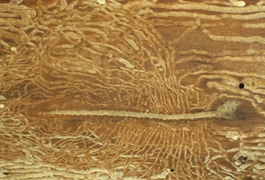
shot hole borer galleries
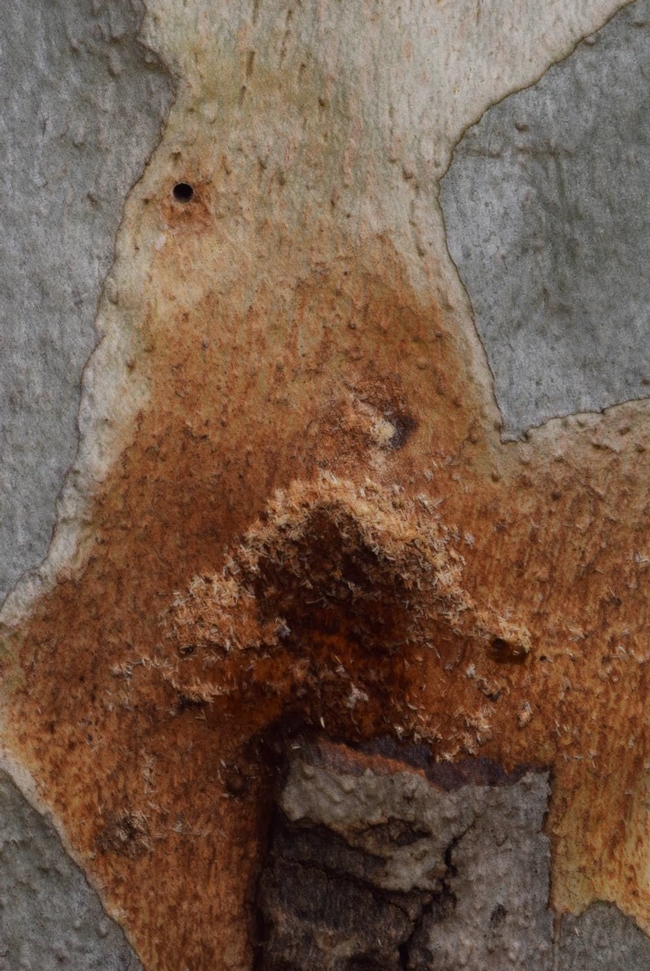
shot hole borer sycamore
Controlling Shot Hole Borer
A recent study by Joey Mayorquin and team shows a promising chemical response in sycamore trees infected with Fusarium Dieback. This holds hope for the pest/disease complex in avocado, as well.
Chemical Management of Invasive Shot Hole Borer and Fusarium Dieback in California Sycamore (Platanus racemosa) in Southern California
Fusarium dieback (FD) is a new vascular disease of hardwood trees caused by Fusariumspp. and other associated fungal species which are vectored by two recently introduced and highly invasive species of ambrosia beetle (Euwallacea spp. nr. fornicatus). One of these ambrosia beetles is known as the polyphagous shot hole borer (PSHB) and the other as the Kuroshio shot hole borer (KSHB). Together with the fungi that they vector, this pest–disease complex is known as the shot hole borer–Fusarium dieback (SHB-FD) complex. Mitigation of this pest–disease complex currently relies on tree removal; however, this practice is expensive and impractical given the wide host range and rapid advancement of the beetles throughout hardwoods in southern California. This study reports on the assessment of various pesticides for use in the management of SHB-FD. In vitro screening of 13 fungicides revealed that pyraclostrobin, trifloxystrobin, and azoxystrobin generally have lower effective concentration that reduces 50% of mycelial growth (EC50) values across all fungal symbionts of PSHB and KSHB; metconazole was found to have lower EC50 values for Fusarium spp. and Paracremonium pembeum. Triadimefon and fluxapyroxad were not capable of inhibiting any fungal symbiont at the concentrations tested. A 1-year field study showed that two insecticides, emamectin benzoate alone and in combination with propiconazole, and bifenthrin, could significantly reduce SHB attacks. Two injected fungicides (tebuconazole and a combination of carbendazim and debacarb) and one spray fungicide (metconazole) could also significantly reduce SHB attacks. Bioassays designed to assess fungicide retention 1 year postapplication revealed that six of the seven fungicides exhibited some level of inhibition in vitro and all thiabendazole-treated trees sampled exhibiting inhibition. This study has identified several pesticides which can be implemented as part of an integrated pest management strategy to reduce SHB infestation in low to moderately infested landscape California sycamore trees and potentially other landscape trees currently affected by SHB-FD.
https://apsjournals.apsnet.org/doi/abs/10.1094/PDIS-10-17-1569-RE
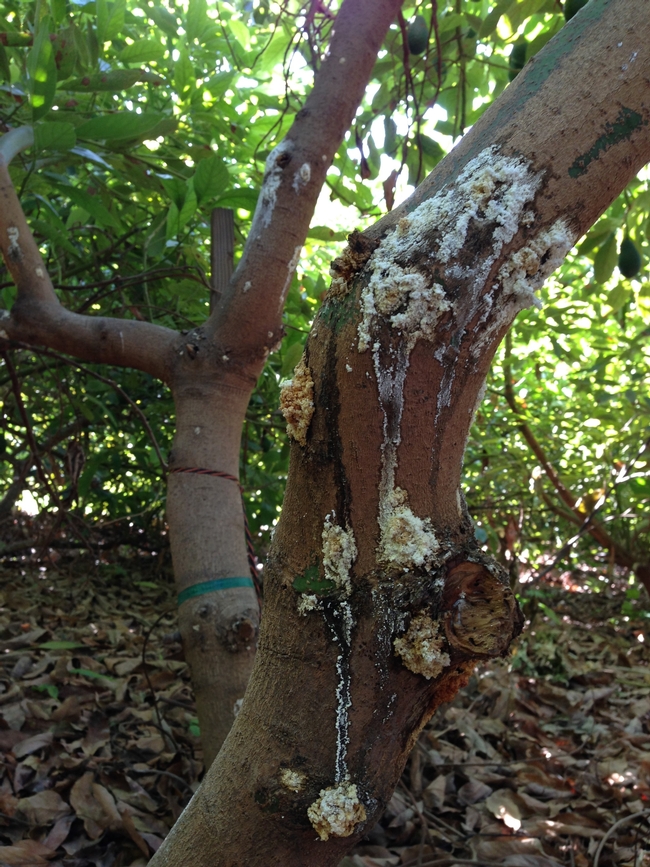
shothole 1
Talkin Borers
UC ANR Integrated Pest Management Program
A sugar volcano is one symptom that shows your avocado tree might be infected with Fusarium dieback, a fungi spread by a beetle called the shothole borer. But what you might see if your tree is being attacked by shothole borer, varies among the different kinds of tree hosts. The symptoms—staining, sugary exudate, gumming and beetle frass—are often noticed before the tiny beetles (1.5–2.5 mm) are found.
As its name suggests, these beetles bore into trees. Near or beneath the symptoms, you might notice the beetle's entry and exit holes into the tree. The female tunnels into trees forming galleries, where she lays her eggs. Once grown, the sibling beetles mate with each other so that females leaving the tree to start their own galleries are already pregnant. Males do not fly and stay in the host tree.
Shothole borers have a special structure in their mouth where they carry two or three kinds of their own novel symbiotic fungi. Shothole borers grow these fungi in their tree galleries. It's these fungi that cause Fusarium dieback disease, which interrupts the transportation of water and nutrients in the host tree. Advanced fungal infections will eventually lead to branch dieback.
Early detection of infestations and removal of the infested branches will help reduce beetle numbers and therefore, also reduce the spread of the fungus.
- Chip infested wood onsite to a size of one inch or smaller. If the branch is too large to chip, solarize them under a clear tarp for several months
- Avoid movement of infested firewood and chipping material out of infested area
Avocado is one tree host. Shothole borers successfully lay eggs and grow fungi in many tree hosts, with some of these trees susceptible to the Fusarium dieback disease. For more information about tree host species, where the shothole borer is in California, and what symptoms look like in other tree hosts, visit the UC Riverside Eskalen Lab website.
Californians can help in the fight against invasive species by learning and participating during California Invasive Species Action Week, June 2–10.
During the week, spend your lunch with us learning the latest about invasive tree killing pests, aquatic nasties like quagga mussels and nutria, and how the invasive weed/wildfire cycle is altering our ecosystems! http://ucanr.edu/sites/invasivelunch/
Content in this post taken from the UC IPM Avocado Pest Management Guidelines. Faber BA, Willen CA, Eskalen A, Morse JG, Hanson B, Hoddle MS. Revised continuously. UC IPM Pest Management Guidelines Avocado. UC ANR Publication 3436. Oakland, CA.
And more about Shot Hole Borers
http://ucanr.edu/sites/pshb/
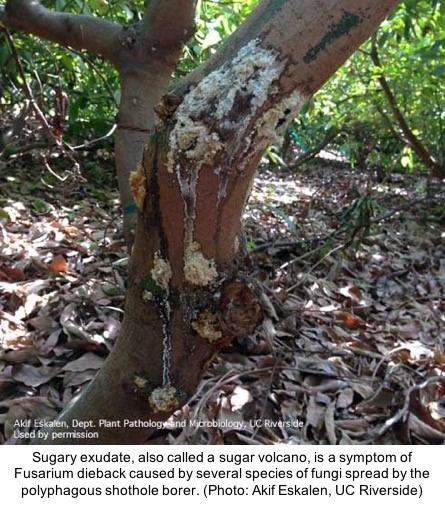
fusarium dieback avocdo
Invasive Shot Hole Borer Gone Global
Natural Resources Advisor, UC Cooperatiove Extension
With a finding in the KwaZulu National Botanical Gardens reported in November 2017, the invasive shot hole borer (ISHB) (polyphagous and Kuroshio borers)/ fusarium dieback pest disease complex is now known to be found on three continents. Native to parts of Asia – polyphagous SHB comes from Vietnam, while Kuroshio SHB is native to Taiwan – the problems has spread to Israel, the US, Mexico, and now South Africa. Since first being discovered, PSHB has been identified in urban areas in parts of the country that are several hundred miles apart – from Durban on the east coast to the large metropolitan area of Johannesburg further north, with the Botanical Garden in-between. Samples from the city of George, in a region on the southern coast known as the Garden Route, are currently being analyzed. South Africans are very concerned about the potential to damage their extensive urban forests and are developing a national surveillance and management plan. KwaZulu National Botanical Garden is part of the International Plant Sentinel Network, where exotic species are grown to provide an early warning system for emerging pests. The US counterpart if the Sentinel Plant Network run by the American Public Gardens Association and the National Plant Diagnostic Network. Finding this pest serves as a case in point on the value of these kinds of international networks in the battle against invasive pests.
Closer to home, there is actually, potentially, maybe some good news from the Tijuana River Valley. This is the valley that has been the hardest hit by the KSHB. In 2015 the natural willow forests were tall and lush and then just a few months later they were devastated - the before-and-after photos of this event have become iconic. John Boland, a researcher working in the Tijuana River Valley reports that in areas that were severely damaged by the pest, the willows are now vigorously recovering. They are growing back from their stumps via long re-sprouts, and this new growth is not showing signs of attack. Surveys in 2017/18 found a 6% median infestation rate, down from a 97% infestation rate observed in 2015/16. The initially observed high infestation rates in the wet forest areas may have been influenced by extremely high sewage pollution into the Tijuana River, and these high infestation rates are unlikely to occur elsewhere. Boland's “soft tree hypothesis” states that willows growing in nutrient enriched waters grow quickly, laying down wood with low density and high water content, i.e., they have ‘soft' wood. This kind of growth promotes beetle infestation, as it's easy to create tunnels, and favorable for the fungal symbiont. Willows growing elsewhere would have ‘hard' wood and suffer fewer beetle attacks. His initial data analysis supports this hypothesis. If true, this would mean that riparian areas with higher quality water could see much less severe infestation. It will be interesting to observe variations in infestation ecology around the region. Damage to avocado groves in California appears to be less severe than initially anticipated – I hope the same is true for natural areas.
Boland, J.M. 2018. The Kuroshio Shot Hole Borer in the Tijuana River Valleyin 2017-18 (Year Three):
Infestation Rates, Forest Recovery, and a New Model. Final Report for US Navy, US Fish and Wildlife Service and Southwest Wetlands Interpretive Association. 74 pages.
Photo: A typical resprouting arroyo willow. The original trunk is large, broken and riddled with KSHB holes. At the time of the photo, the four vertical resprouts were growing strongly and had no KSHB holes. (John Boland)
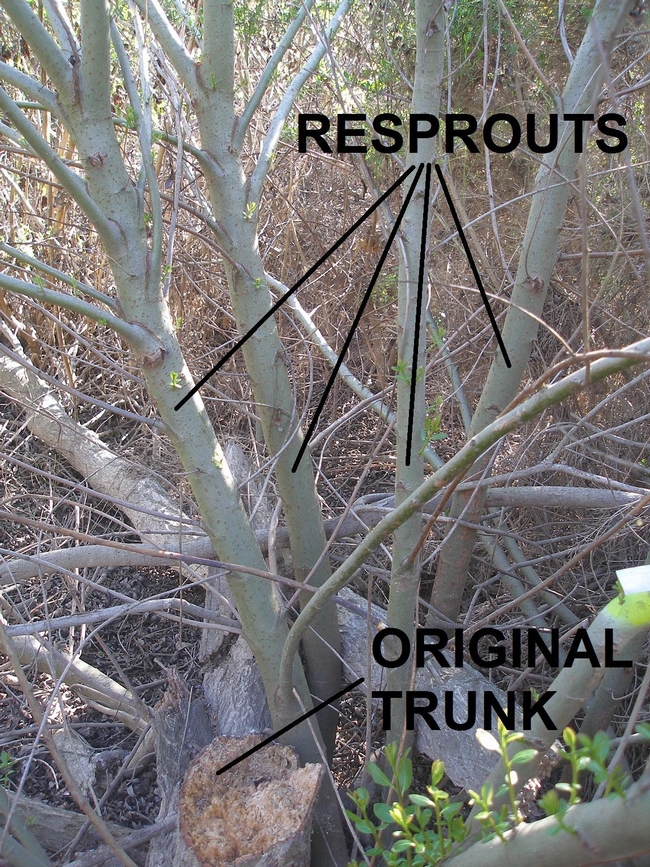
Boland willow
PSHB Found in South Africa
The following is the abstract of a recent article highlighting the occurrence of the invasive shot hole borer that is found in California and described in our blog site:
Invasive species are a problem world-wide and this is an example of how invasives can arrive in multiple countries at the same time and/or how possibly they might move from somewhere like California to another far away country like South Africa. People are the usual agents for carrying these pests around the world.
The polyphagous shot hole borer (PSHB) and its fungal symbiontFusarium euwallaceae: a new invasion in South Africa
The polyphagous shot hole borer (PSHB), an ambrosia beetle (Coleoptera: Curculeonidae: Scolytinae) native to Asia, together with its fungal symbiont Fusarium euwallaceae, has emerged as an important invasive pest killing avocado and other trees in Israel and the United States. The PSHB is one of three cryptic species in the Euwallacea fornicatusspecies complex, the taxonomy of which remains to be resolved. The surge in the global spread of invasive forest pests such as the PSHB has led to the development of programs utilizing sentinel tree plantings to record new host-pest interactions. During routine surveys of tree health in botanical gardens of South Africa undertaken as part of a sentinel project, an ambrosia beetle/fungal associate was detected damaging Platanus x acerifolia(London Plane) in the KwaZulu-Natal National Botanical Gardens, Pietermaritzburg.
Identification of the beetle by sequencing part of the mitochondrial cytochrome oxidase c subunit 1 (COI) gene confirmed its identity as PSHB, and specifically one of the invasive haplotypes of the beetle. The associated fungus F. euwallaceaewas identified based on phylogenetic analysis of elongation factor (EF 1-α) sequences. Koch's postulates have confirmed the pathogenicity of fungal isolates toP. x acerifolia. This is the first report of PSHB and its fungal symbiont causing Fusarium dieback in South Africa. This report also represents the first verified case of a damaging invasive forest pest detected in a sentinel planting project, highlighting the importance of such studies. Given the potential impact these species present to urban trees, native biodiversity and agriculture, both the PSHB and its fungal symbiont should be included in invasive species regulations in South Africa.
The full paper is at:
https://doi.org/10.1007/s13313-018-0545-0
Photo: Infected sycamore which is related to London plane tree.
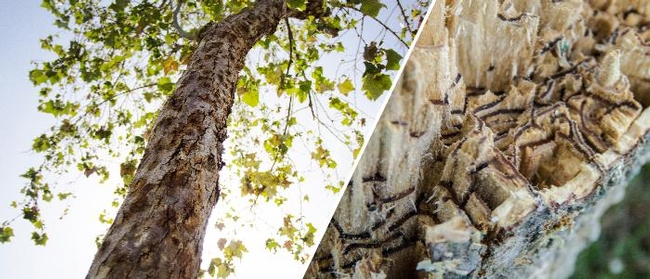
PSHB sycamore
